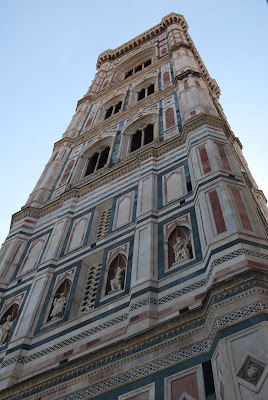The Rick Steves podcast we listened to in Florence was about a Renaissance Walk through Florence. Here are some interesting tidbits that I learned.
Duomo is an Italian word for a cathedral, and it's pretty generic. The Duomo in Florence is the center of Florence. The church started to be built in the 13th-century, but at that time (during the Middle Ages), the people had no idea how to put a huge dome on top of it. So they just built it with a huge hole in the middle of it, and they had confidence that someone in the future would know how to put a dome on top. Wow! What confidence!
Here I am with the Duomo.

The facade that you can see, which is made of green, white, and pink marble, is actually covering up the bricks that the church was made out of. The facade was put up in 1870.

The facade kept the original display of pointed gothic arches and mosaics and statues.



This is the campanile, or the bell tower. It is 270 feet tall, and it was designed in the 1300s. It served as a sculpture gallery - for I don't know how long.

The dome itself was designed by Brunelleschi in the 1400s. He studied the Pantheon in Rome, and then he came back to Florence and designed this! He started with the white "ribs" - that you can see. Then he added the brick and built up - so that the dome supported itself. At the top, he arched the ribs in and kept them in place with the lantern. It took 14 years to build the dome.

After looking around outside, we went inside, and one of the coolest things we saw, in my opinion, was the 24 hour clock!!! When I began preparing to go on this trip, I got to thinking about how Europeans use a 24 hour clock, (as does most of the world, right?) But we don't in the US. And I just wondered - do they have a clock face with 12 hours, and they just know when it's morning and night, so they don't confuse 7am with 7pm? And I wondered if they have numbers on their 12-hour clock faces. I have a watch without any numbers; it has just 4 hatch marks - one for every 3 hours. Do they use clock faces without numbers? I just wondered all of this. And then we walked into the Duomo, and we saw this! It didn't work, but I still thought it was very interesting!

I enjoyed these paintings with the musical instruments in them.


They were just below the clock!

Here you can see Laura, the clock, and the arched-ceiling, too.

There were two organs like this one - one on each side. (There was also a different kind of organ that didn't look as neat or old).

Laura taught me about this because she had seen one in Spain. This is essentially a music stand. The BIG book of music on it was for the choir, which stood nearby. This music stand rotates, so the choir members had to look at it and "memorize" the next few notes and words so they could keep singing until it came back around to them. I think that's pretty cool!

Here is a picture of the floor inside. There were many different designs, and they were beautiful. I have no idea what the OPA stands for. (It was so dark inside that it was difficult to get a good picture of the floor).

And now for the inside of the dome. I mentioned this before, but let me reiterate: I am so glad Laura and I had two cameras with different lenses! Here is a view of the entire dome.

Now it's closer in on the central focus of the picture, Christ.

And now you can really see it!!!

Here is a view of the inner few rings, as well.

And here is Laura with the Duomo, including the dome itself, the campanile, and the octagonal baptistry, which we'll get to next!

1 comment:
OPA: see http://blogs.asaecenter.org/Acronym/2007/06/the_mysterious_opa.html and also http://www.operaduomo.siena.it/english/storia.htm
best,
A.
Post a Comment